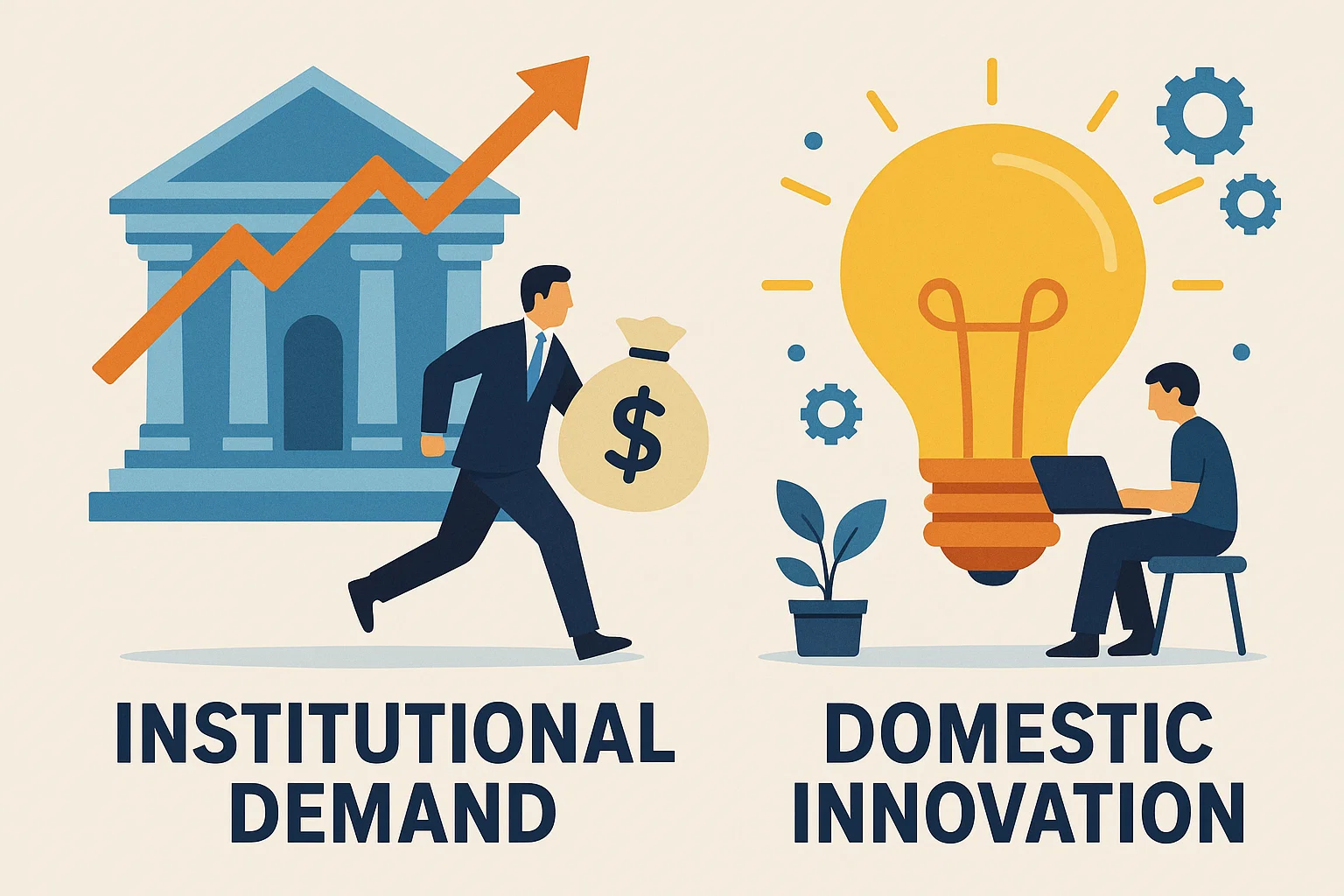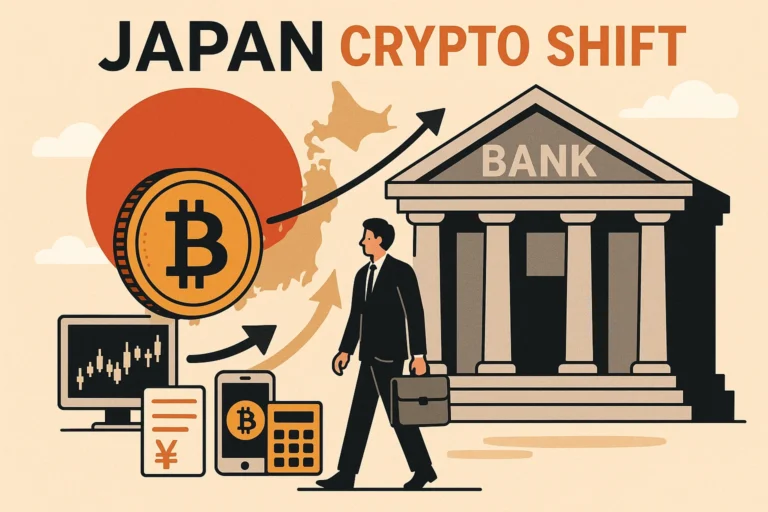Japan Crypto Shift Banks is on the verge of a landmark policy shift that could redefine how traditional finance and digital assets coexist. Reports out of Tokyo indicate the Financial Services Agency (FSA) is considering reforms that would allow Japanese banks to buy, hold, and trade cryptocurrency—a dramatic turn from earlier guidance that effectively walled banks off from the most volatile corners of the digital asset market.
If implemented, this change would signal that one of the world’s most sophisticated financial jurisdictions is ready to move crypto from the periphery into the mainstream of regulated banking. Early details suggest the FSA aims to craft a regime that treats certain digital assets similarly to securities and foreign exchange—demanding robust risk management, capital treatment, and consumer protections.
Japan Crypto Shift Banks
Japan’s Crypto Shift Banks moment did not arrive in a vacuum. Over the past several years, Japan has built one of the most comprehensive rulebooks for crypto exchanges, stablecoins, and tokenized payment rails, blending statutory law with self-regulation by the Japan Virtual and Crypto Assets Exchange Association (JVCEA). That groundwork is now converging with a rapidly maturing institutional landscape.
Japan’s three largest banking groups recently unveiled plans for a jointly issued yen stablecoin, and large depository institutions are piloting tokenized deposit systems—clear signs that digital money is no longer experimental infrastructure but a practical tool for corporate finance and settlement. In this in-depth explainer, we unpack exactly what Japan is proposing, what remains undecided, and what it could mean for banks, investors, and global crypto markets.
What Exactly Is Japan Proposing?
From prohibition to permission with safeguards
According to multiple reports, the FSA is weighing a rule change that would let banks acquire and hold crypto assets such as Bitcoin for investment and trading purposes. This would reverse the effect of 2020-era supervisory guidance that discouraged bank balance-sheet exposure to crypto because of price volatility and operational risk. The contemplated reform would bring digital assets inside the banking perimeter—subject to capital, liquidity, and conduct rules calibrated for a high-risk, high-volatility asset class.
While specifics are still being drafted, the stated intent is to align crypto risk management with the frameworks banks already use for foreign exchange, commodities, and securities. In practical terms, that means risk-weighted assets (RWA) treatment, concentration limits, enhanced market surveillance, and strict custody controls would likely accompany any permission to hold or trade crypto.
Early reporting also suggests the FSA could publish guidance that effectively treats certain digital assets like traditional financial instruments under the Financial Instruments and Exchange Act, expanding the toolkit for insider trading enforcement and market integrity—another sign that crypto is being normalized rather than exceptionalized in the regulatory perimeter.
Still a proposal, not yet the law of the land
It’s crucial to note the FSA’s move is not yet final. The agency appears to be consulting stakeholders and reviewing legal pathways to effect the change. The direction of travel, however, is unmistakable: Japan is steadily migrating from defensive posture to pragmatic integration of digital assets into its financial system, as seen in earlier steps to allow venture funds to hold crypto and to greenlight fiat-backed stablecoins under clear rules.
Why Is Japan Doing This Now?
Institutional demand and domestic innovation
Japan’s institutional landscape is moving fast. The country’s three megabanks—Mitsubishi UFJ Financial Group, Sumitomo Mitsui Financial Group, and Mizuho Financial Group—recently announced a plan to jointly issue a yen-pegged stablecoin to standardize digital settlement rails for corporate clients. This is a powerful signal that large banks see tokenized money as core infrastructure for cash management, supply-chain finance, and securities settlement. Bringing banks’ crypto activity on-balance-sheet under a well-defined rulebook would align regulation with what the market is already building.

At the same time, big deposit-taking institutions like Japan Post Bank are exploring tokenized deposit currencies—not quite stablecoins, but functionally similar for instant settlement on permissioned ledgers. These initiatives underscore a broader thesis: programmable money and digital assets are becoming embedded in mainstream financial plumbing, and regulators want banks—the most supervised entities—to handle them safely.
A mature, layered regulatory model
Japan’s approach pairs statute with self-regulation. The JVCEA operates as a certified self-regulatory organization (SRO), issuing granular rules for exchanges under the FSA’s oversight. That co-regulatory model has already delivered robust AML/CFT, listing, custody, and consumer-protection standards. Extending participation to banks doesn’t start from scratch; it plugs into a framework that has been iterated and battle-tested since the Mt. Gox era.
Are Banks Being Allowed to Buy and Sell Cryptocurrency?
The bottom line today
As of October 20, 2025, Japanese banks are not yet universally authorized to buy and sell cryptocurrency. The FSA is considering reforms to allow this activity under strict conditions, with reporting indicating the goal is to let banks treat crypto more like other regulated financial instruments while applying bespoke safeguards. The specifics—eligible assets, capital treatment, custody models, and client access—will depend on the final text of the reform.
What early guidance indicates
If enacted, banks would likely be able to:
-
Hold crypto on the balance sheet within well-defined limits, potentially starting with highly liquid assets like Bitcoin (and possibly Ether) before expanding to other tokens that meet listing standards.
-
Offer trading and market-making services under surveillance and reporting obligations, similar to FX or securities operations.
-
Provide custody through bank-grade safekeeping solutions or through ring-fenced subsidiaries that meet JVCEA and FSA standards for key management, segregation, and incident response.
The policy direction mirrors an international trend of moving bank-crypto activity from “exception” status to “permissible with controls,” a posture evidenced by other regulators’ recent recalibrations, even if each jurisdiction’s rules differ.
How Would This Change Japan’s Crypto Market?
Liquidity, credibility, and price discovery
Japan Crypto Shift Banks: Banks transacting in cryptocurrency would strengthen domestic market liquidity and tighten price discovery by introducing well-capitalized, compliance-first players that operate under continuous supervision. Bank participation could reduce fragmentation between offshore venues and Japan’s regulated exchanges, narrowing spreads and improving execution quality for institutional and sophisticated retail clients. Over time, this may encourage more derivatives, repo-like financing, and basis trading strategies to move onshore under watchful eyes.
Safer access for corporate treasurers and asset managers
Japan Crypto Shift Banks’ corporate treasurers, who already interact with megabanks for cash, FX, and hedging, can now access digital assets through the same counterparties, simplifying compliance and operational risk. Asset managers would gain bank-grade custody and prime services, potentially unlocking mandates that were previously blocked by risk committees uncomfortable with non-bank service providers. That’s especially relevant for exposure to Bitcoin and Ether as alternative assets in multi-asset portfolios.
A boost to yen-denominated digital finance
Japan’s push on yen stablecoins and tokenized deposits could dovetail with bank crypto services, creating a cohesive ecosystem where fiat on-ramps, settlement tokens, and digital assets coexist on interoperable rails. This would make it easier to do atomic delivery-versus-payment (DvP) for tokenized securities, enable programmable escrow for trade finance, and accelerate DeFi-like functionality inside permissioned networks—without sacrificing regulatory oversight.
What Would the Rules Likely Look Like?
Capital and liquidity treatment
Expect conservative capital charges for unhedged crypto exposure, in line with emerging Basel Committee standards. Even if the FSA adopts a bespoke approach, Japanese regulators tend to hew to international prudential norms. Banks may face higher risk weights for direct holdings and more favorable treatment for collateralized exposures, hedged positions, or exchange-traded instruments with robust surveillance.
Market conduct and surveillance
If crypto is granted status akin to “financial products,” banks will fall squarely under market-abuse and insider-trading rules that already govern securities and derivatives, aligning enforcement with traditional markets. Surveillance expectations would extend to wash trading, front-running, and manipulation, with banks required to implement advanced monitoring and maintain detailed audit trails.
Custody, segregation, and technology risk
Bank custody of digital assets will hinge on hardened key management, multi-party computation (MPC) or HSM controls, clear segregation between bank and client assets, and round-the-clock incident response. Regulators will likely require SOC 2/ISO 27001-style attestations, periodic penetration testing, and business continuity drills. Given Japan’s co-regulatory model, expect the JVCEA to update or align custody guidelines for bank affiliates operating in crypto markets.
How Does This Fit with Japan’s Existing Crypto Laws?
Payment Services Act and stablecoins
Japan Crypto Shift Banks amended its Payment Services Act to recognize fiat-backed stablecoins as “electronic payment instruments,” creating licensing pathways and redemption rules that prioritize consumer protection and 1:1 backing. That clarity, combined with JVCEA rulemaking, underpins why banks feel confident to roll out yen-pegged instruments and why regulators can now consider bringing banks into spot cryptocurrency markets without compromising safety.
Venture funds and innovation policy
In 2024, the Cabinet approved legislative changes allowing investment funds and venture capital firms to hold crypto directly—an early indicator that policymakers view digital assets as legitimate holdings for sophisticated investors within a controlled framework. The banking proposal builds on this trajectory, extending access from fund managers to banking institutions with even stronger prudential standards.
What Will Change for Retail Customers?

Access will likely be staged and chaperoned
Should banks receive permission to deal in cryptocurrency, retail access may roll out in phases. Initially, services could concentrate on institutional and corporate clients, with retail introduced later through advisory-led channels, suitability checks, and education requirements. Banks may also prioritize custody and ETP/ETF-like exposures over direct spot trading for retail customers, mirroring international trends in investor protection.
Better safeguards and clearer recourse
Bank-provided services would benefit from strong complaint handling, transparent fees, and clear disclosure obligations. In the event of operational incidents, retail customers would have recourse within Japan’s established banking redress mechanisms—significantly different from the fragmented landscape of offshore crypto venues.
Global Implications Why the World Is Watching Tokyo
If Japan codifies bank crypto permissions, it would become a G7 template for integrating digital assets into mainstream finance without sacrificing safety. Tokyo’s track record—tight rules, strong SRO collaboration, and willingness to iterate—could influence peers debating how to bring crypto into the perimeter. The symbolic impact is equally important: when megabanks in a top-three economy can legally buy and sell cryptocurrency under prudential guardrails, it sends a message that the asset class has graduated from speculative novelty to a regulated financial instrument.
Key Unknowns to Watch
Scope of eligible assets
Does the first phase cover only Bitcoin (and perhaps Ether) because of liquidity and depth, or will it extend to other large-cap tokens that meet stringent listing standards? The answer will shape both market breadth and compliance overhead.
Balance-sheet versus client facilitation
Will banks be allowed significant proprietary positions, or will exposure be capped with a focus on client facilitation and market-making? Prudential comfort may hinge on strict concentration and VaR limits.
Interaction with stablecoin rails
Japan Crypto Shift Banks will bank crypto activity, interoperate with yen stablecoins, and tokenize deposits? Expect pilot use cases in corporate payments and securities settlement to blend with bank crypto desks, delivering end-to-end digital workflows.
Practical Takeaways for Businesses and Investors
For corporates
Begin mapping potential benefits from on-chain settlement, programmable escrow, and faster cross-border flows—especially where counterparties also bank in Japan. Engage early with bank partners on treasury policies, accounting, and hedging for digital assets.
For asset managers
Prepare governance for mandates that include crypto exposure via bank channels: update risk policies, valuation procedures, and counterparty frameworks. If ETFs, notes, or bank-intermediated spot access become available, onboarding could accelerate.
For crypto natives
Anticipate a more stringent but deeper market. If you operate in Japan, expect higher surveillance standards, more formal liquidity provision, and tighter listing criteria. For international firms, bank connectivity may become a prerequisite to serve Japanese institutions.
Conclusion
Japan’s prospective decision to let banks buy and sell cryptocurrency is more than a regulatory tweak; it’s a strategic integration of digital assets into one of the world’s most advanced financial systems. Building on years of careful rulemaking—stablecoin clarity, SRO oversight, and expanded permissions for investment funds—the FSA’s proposal would normalize crypto within bank risk frameworks, unlock safer access for institutions and, eventually, retail, and turbocharge the development of yen-denominated digital finance. Although the reform is not yet final, the direction is clear: Japan is preparing to lead on responsible crypto modernization, proving that innovation and investor protection can advance together.
FAQs
Q Has Japan already approved banks to trade crypto?
Not yet. As of October 20, 2025, the FSA is considering reforms to allow banks to hold and trade cryptocurrency with strong safeguards. Final rules and timelines have not been published.
Q Which assets would banks likely be allowed to handle first?
Early implementations typically focus on Bitcoin—and possibly Ether—due to liquidity and market depth. Broader token access would depend on listing standards, surveillance readiness, and risk treatment under the new rules.
Q How do stablecoins factor into this shift?
Japan has already created a clear regime for fiat-backed stablecoins and is witnessing major bank initiatives for a yen stablecoin and tokenized deposits. Bank crypto services would likely interoperate with these rails for faster, programmable settlement.
Q What protections would apply if banks offer crypto to clients?
Banks would be subject to prudential capital rules, conduct and market-abuse oversight, robust custody standards, and comprehensive AML/CFT controls—akin to what applies in securities and FX markets in Japan’s hybrid statutory/SRO framework.
Q How does Japan’s approach compare globally?
Japan is moving toward a permissioned with controls model consistent with broader international recalibration—bringing crypto into the regulated perimeter rather than pushing it out. That contrasts with jurisdictions still restricting bank activity or lacking comprehensive frameworks.
See More: Crypto Market News Today Trends, Insights, and Strategy 15-10-2025


